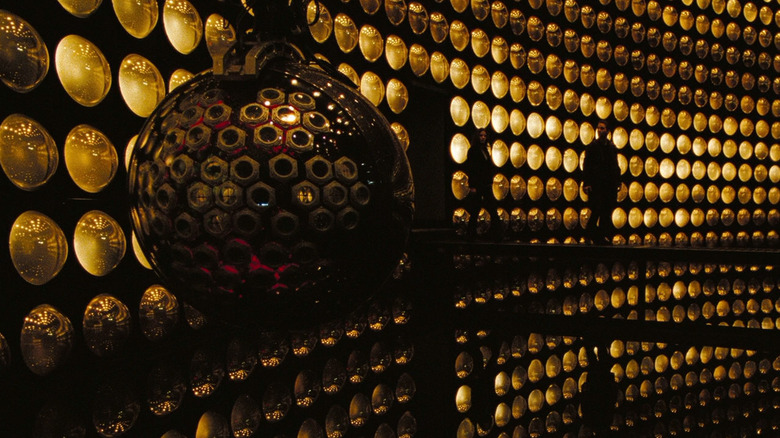This Forgotten Shia LaBeouf Thriller Was Inspired By An Isaac Asimov Story
Isaac Asimov is one of the most famous and celebrated sci-fi authors of all time, part of the "Big Three" of the Golden Age of Science Fiction together with hugely influential authors Arthur C. Clarke and Robert A. Heinlein. Asimov worked within the "hard science fiction" genre, meaning sci-fi with a focus on scientific accuracy.
Asimov's biggest and best-known works are those in his "Foundation" series, which deals with the history of a decaying Galactic Empire, and his "Robot" series, a variety of stories about robotics and their relationship with humans — two series that Asimov eventually merged into a single continuity. But Asimov was also just a very prolific writer, penning more than 500 books, including hundreds of short stories. Many of these have been adapted for the screen, including the popular and successful Apple TV adaptation of "Foundation," and the less popular and successful movie versions of "I, Robot" and "The Bicentennial Man."
Indeed, most of the adaptations of Asimov's writings have been based on his short stories — since they don't have the intricate and rather complicated backstories and lore of his books, a problem that "Foundation" is solving quite gracefully. Such is the case of an underrated and mostly forgotten 2008 techno-thriller starring Shia LaBeouf, which reunited him with director D.J. Caruso after the similarly underrated "Disturbia."
The movie is "Eagle Eye," a thriller very much ahead of its time, which follows Jerry (LaBeouf) and Rachel (Michelle Monaghan) as they are forced to go on the run and become the most-wanted fugitives in America after inadvertently becoming cogs in a plot involving an assassination attempt on the president and a surveillance supercomputer. The movie was loosely based on the equally ahead-of-its-time short story "All the Troubles of the World" by Isaac Asimov.
The ghost in the machine of Eagle Eye
It was originally Steven Spielberg who was inspired by Asimov's story and came up with the idea for what would become "Eagle Eye" in the early 2000s, and was originally meant to direct the film based on a script by Dan McDermott. When Spielberg became too busy with "Indiana Jones and the Kingdom of the Crystal Skull," he dropped out of the project and instead produced the movie, while D.J. Caruso, who directed episodes of the Spielberg TV show "High Incident," became director.
In the original story by Isaac Asimov, the supercomputer Multivac is given increasingly bigger responsibilities to the point where it is virtually leading the entire planet — solving economic, social, and political problems. Problems begin when Multivac is tasked with solving crimes, specifically before they happen. Eventually, Multivac detects a crime that confounds all investigators and even the government — one where the target is Multivac itself. The machine has simply become extremely tired of having all the world's problems on its shoulders and decides it wants to die.
Now, if that sounds a little bit like "Minority Report," you'd be right, which makes sense that the short story would inspire Spielberg, given he was working on that adaptation at the time he thought of the idea for "Eagle Eye." Unfortunately, "Eagle Eye" skips the robot with an existential crisis in favor of a conspiracy thriller for the surveillance state era, with a story about a machine deciding to do away with the government after a botched operation resulted in the loss of American lives.
It's an entertaining film, one reminiscent of Hitchcock movies and '70s conspiracy thrillers, but the addition of a supercomputer that watches your every move has only become timelier since the release of "Eagle Eye" in 2008. After all, it wouldn't be until 2013 that Edward Snowden revealed the extent of the government surveillance programs in the U.S. and Europe.

